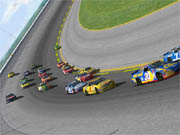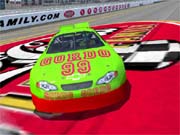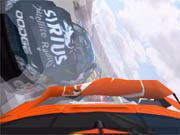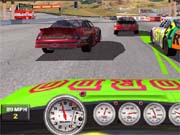It wasn't so very long ago that the only truly realistic PC racing games were Papyrus racing games. Times have changed, of course, and now several development houses and publishers have access to the concepts and programming know-how that turn run-of-the-mill arcade racers into deep and authentic portrayals of motor sports. Still, with just a single product, Papyrus Design Group continues to hold its own. The latest in its revered NASCAR series, NASCAR Racing 2002 Season, proves once again that Papyrus is one of the most faithful and knowledgeable purveyors of racing games on the planet. It also proves through a wide variety of new drivers' aids and tutorials that the hard-core Papyrus team has finally made the series more accessible to the many rookie and arcade-schooled drivers who once found the series prohibitively difficult. NASCAR 2002 is not the quantum leap ahead some might have expected, nor is it free of flaws, yet it is another winning installment of what clearly can be considered the standard-bearer of all racing simulations.

As expected, NASCAR 2002 is licensed to the hilt and is consequently equipped with all the venues, drivers, cars, paint schemes, and sponsors of the 2002 Winston Cup season. Perennial top finisher Dale Jarrett is here, as are Bobby Labonte and Jeff Burton. Sizzling newcomer Tony Stewart brings his #20 Home Depot Pontiac, and four-time Winston Cup champion Jeff Gordon pilots his #24 DuPont Chevrolet. All the circuits from NASCAR 4 return for another go, including the high-speed monster known as Talladega and the confining accident scene that is Bristol.
Whereas NASCAR 4 offered 21 circuits, NASCAR 2002 delivers three more for an impressively grand total of 24. Included in the trio are the latest real-life Winston Cup additions of Chicagoland Speedway and Kansas Speedway, both of which are near-identical 1.5-mile low-banked tri-ovals that feel substantially more exciting during a race than they outwardly appear. Though Papyrus seemingly hasn't endowed either with more than just a basic allotment of peripheral scenery, it has once again managed to highlight the subtle track surface and banking variations that make these two new NASCAR circuits as different as they can possibly be.
Conversely, the third and final new track is pure fantasy. Presumably named after a certain soda pop of some renown, the Coca-Cola Superspeedway is undoubtedly where you'll want to head to determine just how fast your virtual car can go. Featuring two monstrous 36-degree banked corners and two massive straightaways, this imaginary and perfectly symmetrical facility asks only that you leave your accelerator matted, the brake pedal untouched, and remain aware of how weightless you're going to feel at such tremendous speeds. At Coca-Cola, a 240mph-plus top speed is not uncommon, nor is three-abreast racing, and there's a very real likelihood that if you do crash, your momentum will probably carry you for a half-mile or so until you eventually lurch to a stop. Certainly fans of reverse-track racing and head-on multiple-car collisions now have a new marquee venue in which to hone their craft and run up their destructive totals.
Yet it is the rookie driver, not the crash-happy renegade, who stands the most to gain from the latest NASCAR. Apart from the usual collection of drivers' aids such as automatic clutches, antilock brakes, traction control, simplified "arcade" mode, and unbreakable cars, NASCAR 2002 offers several important and helpful new perks. The most significant addition is undoubtedly the game's driving school component, a 10-lesson tutorial where newcomers will familiarize themselves with the essentials. Addressing such issues as rules, pitting, car tuning, general driving skills, and even graphics-performance maximization, the two-hour-plus driving school is a wonderful primer that is clearly not a last-minute throw-in. Unfortunately, though all the lessons are fully narrated and definitely informative, they are not interactive like those that accompany Electronic Arts' slick F1 series.

NASCAR 2002 is also the very first NASCAR sim to offer complete tours of each and every facility. Narrated by stock-car legend Darrell Waltrip, this is a particularly interesting place to turn for both a general indoctrination and for guidance when certain circuits or sections of circuits seem troubling. Rookie drivers will also appreciate NASCAR's new optimum-driving-line graphical overlay, a colored on-track display that changes color to reflect braking and cautionary zones and is positioned to indicate the ideal car placement. And certainly anyone who drives with a keyboard will immediately take advantage of NASCAR's new digital steering-assistance function, which graduates and tempers the usually violent responses that typically accompany non-analog keyboard control.
Veteran NASCAR aficionados may not be so easily impressed. Though the game does sport several interesting new wrinkles that will impress the hard-core driver and enhance what was already an exceptional experience, it is far from an entirely revamped product, nor does it totally clear up the few trouble spots of past editions. Frame rate, for example, continues to be a problem. On the test system, which includes normally capable components such as an Athlon XP 1600+ processor, a GeForce2 GTS 64MB video card, and 512MB RAM, we were hard pressed to maintain a smooth-flowing display in traffic unless we first reduced several detail levels and dropped the resolution from the preferable 1024x768 to 800x600. It is disappointing that NASCAR once again forces you to choose between performance and appearance.
The game's artificially intelligent competitors also continue to exhibit several of the quirks they've displayed in the past. When running under a yellow flag, they appear disorganized and more than willing to add to the mayhem by perpetrating low-speed crashes not only into each other but also into their human peer. During un-flagged conditions, they absolutely refuse to crash on the game's large, wide ovals, yet knock the stuffing out of one another again and again at short bullrings such as Bristol. They'll maintain a robotic behavior for the first few laps of a race and, unless interrupted by a crash, continue to motor along as a single entity within mere inches of each other's bumper even after a half hour of hard racing. This sort of conduct is a bit too tight for even the normally close-knit world of real-life NASCAR.

However, it is important to remember that such criticisms are valid only because Papyrus has failed to iron out such relatively trivial foibles since the last edition of the game. In the big picture and especially when compared to most other racing simulations, the NASCAR AI and in fact the entire NASCAR driving experience are nothing less than superb. As is typical for the series, NASCAR 2002 generally portrays weight, momentum, and grip concerns and the ebb and flow of the surrounding pack in an impeccable and highly realistic fashion unmatched anywhere in PC racing. Papyrus has also emphasized the effects of drafting this time around so that drivers absolutely must moderate their actions in relation to the proximity of nearby cars or find themselves out of the draft and falling helplessly to the back of the field. And now, if and when you do happen to make your way to the point, you'd best be prepared to fight off the constant advances of the cars tucked in behind that are in turn taking advantage of the higher top speed a draft creates. Unless you pit a screaming demon against low-grade competition, there will be no running away and hiding in this game.
There will, however, be loads of glorious sound effects. Though recent versions of NASCAR have made vast audio strides, none have approached this level of quality and variety. Now, instead of the familiar NASCAR Racing low-level roar, the engine sounds guttural and tortured and very, very complex. The transmission delivers a symphony of audible burps and grinds. And the tires have never, ever been this informative. Apart from the usual squeals and chirps you'll hear when you overdrive a turn, they'll emit a low-level whirr as they carve through virtually any corner. The tighter the turn, the more noticeably the tires complain.
NASCAR 2002 is also the prettiest NASCAR to date, but only by the slimmest of margins. The cars do seem a bit cleaner and more capable of bent and warped body parts. The pavement looks grittier and more detailed. Light sourcing seems slightly more realistic. Yet whatever on-track graphics alterations have been enacted are perceptible only when conducting painstaking back-to-back tests with NASCAR 4. Otherwise, Papyrus has definitely redesigned the game's off-track interfaces to look more polished and professional. It has also added an option with which new drivers can remove some of the more sophisticated menu items and thereby simplify their prerace setup process. Certainly one of the game's most advantageous perks is the oh-so-welcome return of the instant race restart, a function that's sadly been absent from the series since its earliest iterations. Now, drivers are no longer forced to endure the entire race-reloading process should they make a grievous on-track error. Instead, they'll merely click a button and immediately be placed back on the starting line in a fresh, undamaged automobile.
Whether you opt to restart the race or soldier on, the NASCAR 2002 replay feature is more than ready to accommodate the viewing of any number of laps or accidents. The NASCAR series has always offered one of the finest replay suites in the business, giving you access to such amenities as variable speed control, cutting and editing functions, and more camera perspectives than anyone could ever fully explore. Yet the latest game raises the bar even further by letting drivers insert sound files and still images to construct their own bizarre creation. Papyrus suggests placing a dunce cap on your buddy's car after he's committed a serious boo-boo, a concept that will undoubtedly be taken to heart by many in the NASCAR fraternity.

Multiplayer NASCAR continues to support up to 42 human drivers via a network or Internet connection. Dozens of races are seemingly available at any time of the day or night via Sierra's no-charge online service, and most of them inevitably feature numerous talented and aggressive car jockeys. As in NASCAR 4, drivers will be compelled to reduce graphics detail to a minimum or suffer through a ton of warping, yet multiplayer NASCAR sports some of the most enjoyable human-vs.-human competition currently available when played through a fast Internet connection and computer.
As has been the case since its 1994 introduction, NASCAR Racing remains one of the very finest racing games on the market. Its latest version offers plenty of incentive for those who may have been intimidated in the past, and its innovations should be enough to encourage many veterans to come back for another go. However, if you're one of the many owners of NASCAR Racing 4, paying $49.95 for what is in essence an elaborate revision may not be suitable when the next true upgrade is undoubtedly already in the garage being prepped.